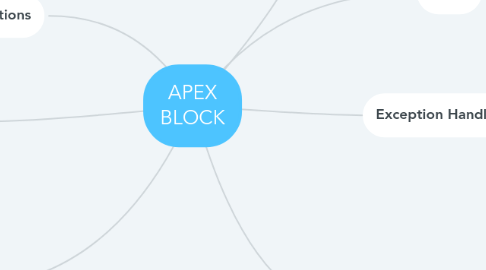
1. Collections
1.1. List Similar data type values
1.1.1. Create
1.1.2. Add
1.1.3. Remove
1.1.4. Traverse
1.2. Set Unique sorted
1.2.1. Create
1.2.2. Add
1.2.3. Remove
1.2.4. Traverse
1.3. Map Pair of <Key,value> Unique sorted - key
1.3.1. Create
1.3.2. Add
1.3.3. Remove
1.3.4. Traverse
1.4. for each to access each element
2. Assertions
2.1. System.assert
2.2. System.asertEquals
2.3. System.assertNotEquals
3. Annotations
3.1. @isTest
3.2. @future
3.3. @Rest Resources
4. #1 Salesforce Training Institute
5. OOPs
5.1. Object Oriented Progrmming
5.1.1. Encapsulation
5.1.1.1. Class
5.1.1.1.1. Business Class
5.1.1.1.2. Built in Class
5.1.1.1.3. Service Class
5.1.1.1.4. Test Class
5.1.1.2. Interface
5.1.2. Abstraction
5.1.2.1. Private
5.1.2.2. Protected
5.1.2.3. Public
5.1.2.4. Global
5.1.3. Polymorphism
5.1.3.1. Overloading
5.1.3.1.1. Constructor Overloading
5.1.3.1.2. Method Overloading
5.1.3.1.3. Operator Overloading
5.1.4. Inheritance
6. Exception Handling
6.1. Try
6.2. catch
7. Database Statements
7.1. DML
7.1.1. Data manipulation Language Carries Data from Controller to Model
7.1.1.1. insert object | collection
7.1.1.2. update object | Collection
7.1.1.3. upsert object | collection
7.1.1.4. delete object | collection
7.1.1.5. undelete object | collection
7.1.1.6. merge
7.2. SOQL
7.2.1. Salesforce Object Query language
7.2.1.1. select id, f1,f2,f3, from sObject where condition limit max offset skip
7.2.1.1.1. Parent to Child
7.2.1.1.2. Child to Parent
7.3. SOSL
7.3.1. Salesforce Object Search Language
